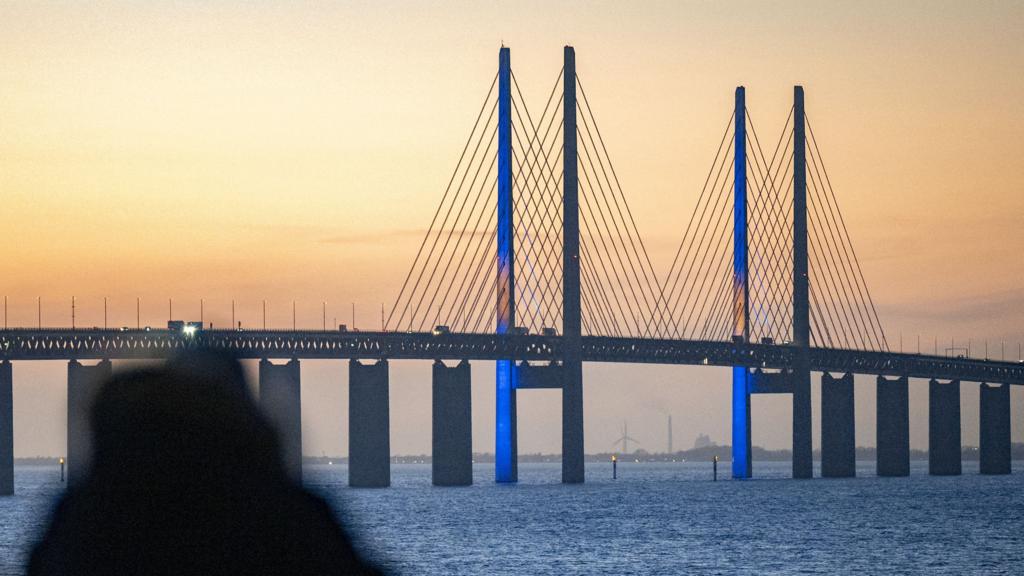The Öresund Bridge, a landmark transport link connecting Denmark and Sweden, marks its 25th anniversary. Despite its significant regional impact, challenges persist.
Oskar Damkjaer, 28, commutes from Copenhagen to Malmö, Sweden, twice a week. He utilizes the 40-minute high-speed train journey for work.
“Commuting to another country might seem like a big deal,” says the software engineer at Neo4j, “but it’s quite convenient.”
In Copenhagen, Laurine Deschamps works at IO Interactive, commuting four times a week from Malmö.
“Some prefer Copenhagen’s bustling city life,” says the global brand manager.
“I prefer Malmö – a human-sized, walkable city.”
Their experiences embody the vision behind the 1991 agreement to build the bridge.
The goals were to expedite travel, enhance regional integration, and stimulate economic growth.
The project cost 30 billion Danish krone ($4.3 billion; £3 billion) and took five years to complete.
The 16km link, including a tunnel, is the EU’s longest road and rail bridge.
Its striking design and cinematic views inspired the successful TV series “The Bridge.”
New figures from Öresundsinstitutet highlight the bridge’s impact on transport and business.
Cross-border commuting has increased by over 400%.
The number of Swedes and Danes relocating across the bridge has risen by more than 60%.
The link has facilitated the creation of thousands of businesses on the opposite side of the water.
There has been a 73% increase in these companies, according to Öresundsinstitutet’s data.
“We have a unique opportunity to go back and forth,” says Sandra Mondahl of IO Interactive.
“I can contribute to game development in both Denmark and Sweden,” says the 33-year-old from Copenhagen.
Research suggests over 100 businesses have relocated headquarters or offices to Malmö, creating jobs.
These include parts of Ikea Group and Ikano.
“Many Danish firms place Swedish offices in Malmö instead of Stockholm,” says Johan Wessman, CEO of Öresundsinstitutet.
Malmö’s appeal lies in its modern office space, proximity to Copenhagen Airport, and access to a skilled labor pool.
The bridge has also driven innovation, with a surge in tech start-ups and life science companies in Malmö. Lund University research indicates a steeper increase in patents compared to Gothenburg and Stockholm.
A separate study suggests Danish-Swedish trade is 25% higher due to the bridge.
Öresundsinstitutet’s research indicates that record numbers of people commuted by train in 2024 – making almost 41,000 journeys per day.
This reversed a dip during the pandemic, when border controls and reduced services caused major disruptions.
However, overcrowding is becoming an issue, with solutions not expected until 2030.
Despite company relocations, Malmö needs to attract more commuters from Denmark. Over 95% of commuters travel from Malmö to Copenhagen.
“Malmö is a regional city with fewer high-level jobs and lower salaries than Copenhagen,” explains Wessman.
Boozt, a Danish-owned marketplace, is moving its headquarters to Copenhagen.
CEO Hermann Haraldsson says attracting young Danish talent to Malmö has become challenging.
“There’s a mental barrier for Danes to work in Sweden,” he says, despite longer commutes within Copenhagen.
“Applications have tripled since the move was announced.”
Haraldsson also finds commuting too expensive.
A one-way train ticket costs around $17, while driving costs about $80, with discounts for regular travellers.
He also cites administrative hurdles due to differing pension, parental leave, and unemployment insurance systems.
A new agreement aims to simplify income tax rules.
Cultural integration has also been challenging, says Wessman.
Differences in working cultures can hinder understanding “despite good intentions.”
“Danes are more direct, while Swedes seek consensus,” says Mondahl.
“There were many meetings and everybody needed to be ‘heard’,” she says of her initial experience.
Despite these challenges, the bridge remains a global icon for cross-border collaboration.
It inspired the Fehmarnbelt tunnel between Denmark and Germany. Finland is also exploring a bridge connecting Vaasa and Umeå.
Wessman argues that fixed links are crucial given the war in Ukraine and Sweden and Finland’s NATO accession.
Swedish and Danish authorities are discussing new connections, including tunnels from Helsingborg or Landskrona, and a Malmö-Copenhagen subway.
“It will take years before the next connection is ready. But it will come, and it will be needed,” says Wessman.
The 18 year olds will join males in a lottery that could require them undergo a period of service.
In Lithuania and Australia, hungry fly larvae are used to process food waste into useful protein.
The boss of mobile gaming giant Supercell says the industry needs to take bigger risks to compete.
Brough residents have long complained about commuters blocking access to their properties.
The case has been described as the biggest environmental scandal in Sweden’s recent history.

